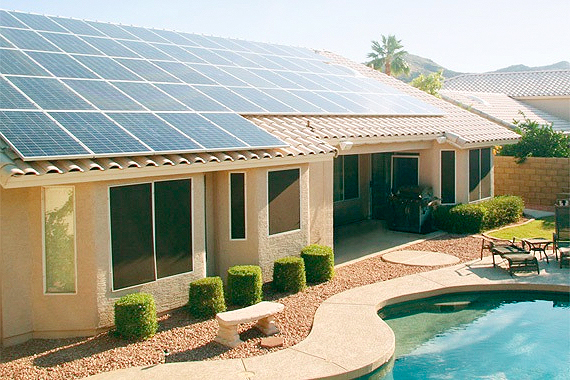Trying to convert the sun’s rays into electricity doesn’t make sense for every home owner. For the solar panels that typically sit on your roof to be really effective, they need exposure to direct sunlight for at least five hours a day. If there’s a lot of fog and rain where you live, or obstructions like trees or neighboring structures, your solar system won’t be as efficient.
But if your electric bills are high and your house receives sufficient sunlight, solar panels might be a sustainable and energy-efficient alternative to consider. Prices have been falling in recent years. But even so, your payback period will be decades.
How Many Watts?
Solar-panel systems are classified by watts of capacity. Systems under 10 kilowatts — 1 kilowatt equals 1,000 watts — are primarily for residential use. The average size of a residential solar-panel system is 5.2 kilowatts. Installation cost varies by the size of the system and the state where you install it, but averaged $6.10 per watt nationally in 2011, according to the U.S. Department of Energy’s Lawrence Berkeley National Laboratory.
The median installed price of PV systems less than 10 kW in size that were completed in 2011 ranged from $4.90 per watt in New Hampshire to $7.60 per watt in Washington, D.C., the lab’s data shows.
However, once local, state, and federal tax incentives were factored in, the installed cost of a 5.2-kilowatt system in 2011 ranged dropped byfrom a range of $0.90 per watt to $1.20 per watt for systems.
In general, systems are cheaper in places like Arizona and California, where electricity is expensive, sunshine is plentiful, and solar has gained wider acceptance. Search the Database of State Incentives for Renewables & Efficiency for state and local incentives.
IRS Expands Federal Tax Credit
Systems installed between Jan. 1, 2009, and Dec. 31, 2016, are eligible for a tax credit equal to 30% of the cost. To qualify, the system must supply electricity to a residence and meet local building codes.
That means a 5.2 kilowatt system that costs $44,200 would, in theory, earn a federal tax credit of $13,260. (This is a simplified example. Consult a tax adviser.)
The tax break can be applied to a solar-panel system installed at your primary residence or second home. Take the credit for the tax year the system becomes operational. Use IRS Form 5695. The credit can’t exceed the total amount owed in federal taxes for that year, but it can carry over to future years. Save receipts and certification statements.
Reduce Your Electric Bills
A typical residential system should lower your electric bills by 25% to 50%, says Monique Hanis, a spokeswoman for the Solar Energy Industries Association. The average household pays about $110 a month for electricity, according to the Energy Department, so a solar-panel system should save you between $300 and $600 a year. The payback period will vary greatly depending on how sunny it is where you live, the size of your system, the cost of your system, and future swings in local electricity costs.
Figure it’ll take anywhere from six to 18 years, says Hanis. Solar panels have a lifespan of 20 to 30 years. HouseLogic tried out some independent online tools that estimate your solar panel payback period, and they showed it could take more than 30 years in some cases.
Producing excess energy can accelerate how quickly you’ll recoup your investment. A battery can store extra electricity for later use, or you may be able to sell surplus energy back to the utility company in a practice called net metering. Many cities have net metering in place, but check with your utility company before you install solar panels.
Solar Caveats
Before you install solar panels, be sure your roof is in good shape. If it isn’t, you might need to shell out $5,000 or more on repairs to make your roof structurally sound. This expense doesn’t count toward the federal tax credit. You might also need to cut down trees that block direct sunlight.
Energy Star, the federal program that promotes energy efficiency, doesn’t rate solar panels. Look for an installation company that offers a warranty on the system for at least 20 years. If feasible, go with an installer that’s familiar with the permit process of your local zoning board. According to Hanis, getting a permit can be one of the most challenging aspects of a solar project.
Make Your Home Efficient First
Take fundamental steps to improve your home’s energy efficiency before resorting to solar panels. Conduct your own energy audit, seal windows and doors, and replace old appliances. Simply adding insulation to an attic can lower heating and cooling bills by 10% to 50%. A tube of caulk and a few rolls of fiberglass insulation cost a whole lot less than solar panels.
This article provides general information about tax laws and consequences, but should not be relied upon as tax or legal advice applicable to particular transactions or circumstances. Consult a tax professional for such advice.
